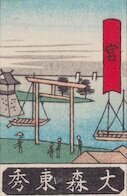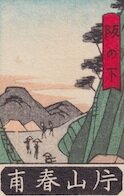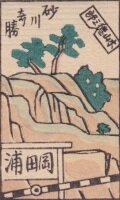Gallery 8B: Landscape Matchbox Series
The artwork in this gallery is from several sets of landscape series produced as matchbox prints. Although created for this miniature print genre, it is unlikely that these were ever meant to be affixed to matchboxes but were instead created for matchbox print collectors.
Tokaidō Road
The first set is titled Tokaidō Gojuusan Tsugi Yado Eki Meishō (Famous Sights of the 53 Stations of the Tokaidō). The description of the set notes that is is the “first Generation” (first user of the artist’s name) Hiroshige, specifically Ichiryuusai Hiroshige Gou who is famous for many versions of the Tokaidō Road series, including a smaller koban sized set. The Tokaidō Road connected the two major cities of Edo (Tokyo) and Kyoto and included 53 stations to stop and rest which were spaced for official runners to carry messages quickly. This set is based on the Novel Shank’s Mare, a tale of the humorous adventures of two men, Yajirō and Kitahachi, traveling along the Tokaidō Road.
The label for this series uses the traditional characters for Hiroshige along with the unusual character Gou which translates “brush”. However, this set was created in the 1920-1930s, well after Hiroshige’s death. The text at the bottom of each matchbox print identifies the name of a matchbox exchange group, the block cutter, and the name of the sponsor of each item. One of the images of a traveler as well as the image for Kyoto include the name Yoshimoto Soutarou, who also commonly appears in postcard exchanges.
Osaka Sights
This series depicts sites in and around Osaka and was printed using only blue tones with the exception of the cartouche. These blue prints are referred to as Aizure-e. Several locations remain to be identified, but those that have are all within Osaka except for the depiction of the city of Amagasaki. The sponsor for this set is Minami Kichijirō. Images are approximately 3.3 x 5.3 cm in size.
Railway Series
This set is a series of stops along one or more rail lines associated with the Nankai Electric Railway. Each print identifies the name of a station along with a point of interest near the station. The prints also identify the sponsor for specific prints in the diagonal notched rectangle, a reference to a punched railway ticket . Prints are approximately 3.2 x 5.2 cm in size.
Takojizō Shrine near Takojizō Station
Reigen Hot Spring near Yoshiminosato Station
Ōtori Jinja near Hamadera Station in Sakai City
Ebisu Bridge in Nanba, Ōsaka
Sumiyoshi Lantern Tower near Sumiyoshi Station
Tannowa Nisanzai Mound near Tannowa Station
Shin Wakanoura in Wakayama City
Abe Ōji Shrine near Kishinosato Station
Fishing in Tana River near Fuke Station
Horse Race Track near Haruki Station
Modern Houses near Suwanomori Station
Sea Bathing near Hamadera Station
Shippōryūji, a Temple on Mount Inunaku near Sano Station
Kasuga Shrine near Tsuruhara Station
Culture Village near Kyarabashi Station in Takaishi City
Okiku Temple (Hōfukuji) near Tottorinoshō Station
Hida Red Light District near Haginochaya Station
Seacoast near Takashinohama Station
Mount Takatsuka near Konohama Station
Sunagawa Kishō Limestone Formation near Okadaura Station
Matsutake Mountain near Kyōshi Station
Tayama Inari Shrine near Hakotsukuri Station
Sunaoka (?) Mound near Sukematsu Station
Pine Trees Along the Shore near Tamade Station
Rinshōji Temple near Tarui Station
Ogawa Hot Spring near Ozaki Station
Shitennō Temple in Ōsaka
This print to the left was included in the midst of the railroad set in the collector’s album that serves as the primary source of matchbox prints in the collection. However, this print comes from a set illustrating the Saigoku Kannon Pilgrimage, a visit to thirty-three Buddhist temples throughout the Kansai region of Japan. Although included in that set, this temple is not one of the 33 temples associated with the pilgrimage.








































































































































